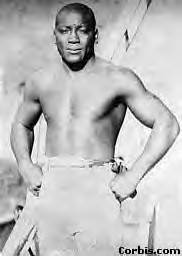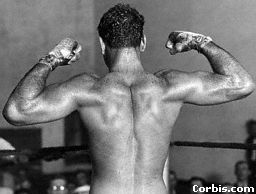Open Your Eyes: Steroids In Boxing
by Charles Farrell (May 17, 2005)
In my column for Boxingranks.com of April 3rd, I twice alluded to potential problems that James Toney might encounter in his April 30 WBA title challenge against champion John Ruiz.
Referring to how Ruiz might defeat Toney in their fight, I wrote:
"He will test Toney's damaged areas, most notably his biceps, to determine whether James is sound. If Toney's body—recently suspiciously enhanced looking—is subject to meltdown, it could determine the outcome of the fight."
Later in the piece, I mention that "Toney has never been close to being stopped in his long career, and it's unlikely that Ruiz will be able to accomplish the trick unless Toney's body betrays him—if his Achilles tendon gives, his bicep tears in some way, or an unforeseen malady resulting from weight-training related activity confound him."
I was hesitant to come right out and say what I knew to be true because I wasn't interested in being sued for libel.
But if people who are intimately connected to the day to day business of running boxing—the commissions, promoters, various television network executives, managers, and trainers—don't yet know that steroids aren't confined to James Toney, that the heavyweight division in particular is rampant with steroid-enhanced physiques, then they're not only incompetent, they're also imbeciles.
But, as I say, I don't want to be sued. Nor do I want Boxingranks.com to be sued. So I won't mention names. The article will make reference to recent events that have occurred in boxing. Astute readers will be left to connect the dots themselves.
There are currently at least six top heavyweights—if one is to include Toney—who are or have been steroid users. One fought recently. Three others have significant bouts coming up in the near future.
Steroid use has caused two of them to lose strange meltdown losses, one a total discombobulation, the other a peculiar injury-induced decision to quit during a fight in which he had merely to hang on for a few more minutes in order to win.
Two of the others behave in decidedly peculiar ways that make them among the least reliable fighters in decades.
Finally, there is a legendary boxing figure, known as one of the great overachievers in boxing history, whose misperceived horrible conditioning is a product of steroid enhancement. The cosmetic sleight of hand that has buffaloed boxing writers and commentators for the last twenty years—he is perceived to be a well-conditioned fighter—is one of the prime examples of why people in the business need to learn their trades. This fighter looks spectacular, but has always had serious stamina problems.
Frankly, I couldn't care less whether a fighter uses steroids. It's a foolish thing to do, and it doesn't help the fighter using them in any way. It reduces their stamina and makes their bodies susceptible to tears, rips, and assorted body breakdowns. It bulks up their muscles in ways that detract from their punching power.
Part of the problem has to do with contemporary images of what constitutes both a good body and its corresponding association with how this relates to good conditioning. This image notion is cultural and class-based. Americans in particular are ardent admirers of Body Beautiful types, but there's a brain versus brawn dichotomy that always attends class consideration.
It's instructive that some of the greatest fighters ever—and many who've emerged just prior to this marketing fueled obsession with a type of cosmetic fitness—were foreign fighters with great boxing bodies, but who by today's image standards wouldn't be considered well-built. Carlos Monzon, Salvador Sanchez, and even Roberto Duran didn't have big muscles, ripped abs, or well chiseled builds. But they easily pushed around guys who were built like powerhouses.
One of the reasons for their being able to do this has to do with the specificity of boxing workouts and exercises. Good boxing training entails far less cross-training than many other sports. In spite of high-tech developments that have shown up over the past quarter century, boxing's tried and true, old-school training methods far surpass any in current use.
Harry Greb, arguably one of the two or three greatest fighters ever, is a persuasive example of how wayward some of our thinking about what constitutes a "good" boxing physique has become. There is little film footage of Greb, but some of what exists is instructive.
There's a clip of Harry shot from medium range. He's on the roof of a building, standing in what may be a handball court. He's wearing his boxing trunks. Greb is a small man with a slightly sunken chest and small, although well-defined, biceps. He, at middle distance, does not appear to have visible abdominal muscles.
Then the camera tracks in to close-up, moving over the range of his body. At this distance, it becomes evident that he's a perfectly constructed vehicle made to fight. There's nothing about his body that has given way to useless display. His musculature is, when viewed through the closer camera distance, actually well developed, but it isn't bunched; although there is no excess whatsoever, the muscle is loose muscle, developed solely to throw lots of punches easily and to be flexible when in motion. You can see that it's a physique that's structure has been formed for intense activity and for going long distances in fights. It's a body that won't break down.
The problem is that, fighting skills aside, Greb would have a hard time convincing the folks at HBO and SHOWTIME that he was worth taking a risk on. He didn't have the "right look."
Until we are able to successfully change the concept of what a fighter's body is supposed to look like, or until we can convince fighters that high-tech steroid enhanced methods of muscle development are detrimental to their ability to punch, withstand a punch, and fight over main event length distances, we'll remain in the sorry position of seeing our boxers mistaking Mr. Olympia physiques—in Toney's case, merely huge biceps and augmented yet flabby pecs—for good conditioning.
In most ways, boxing ultimately takes care of itself in a kind of Darwinian winnowing. Boxers who can't box get exposed by those who can. Juiced up heavyweights get embarrassingly knocked out or are forced to quit in fights while facing journeymen.
You can't market a fighter who goes into a steroid meltdown and winds up falling flat on his face while fighting a novice, no matter how bulked up he's become, no matter how impressive his body looks when viewed through a mass mediated concept of what a fighter's body should be.











